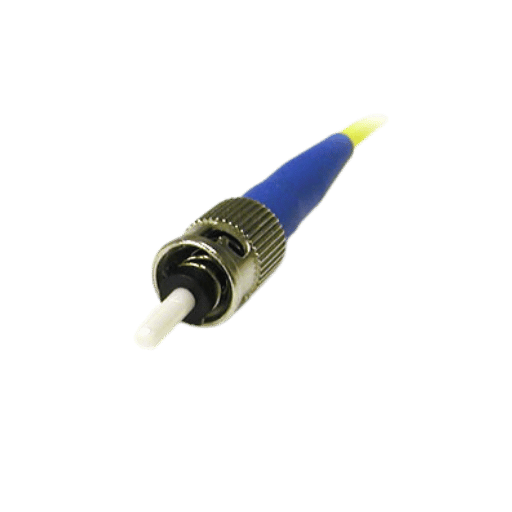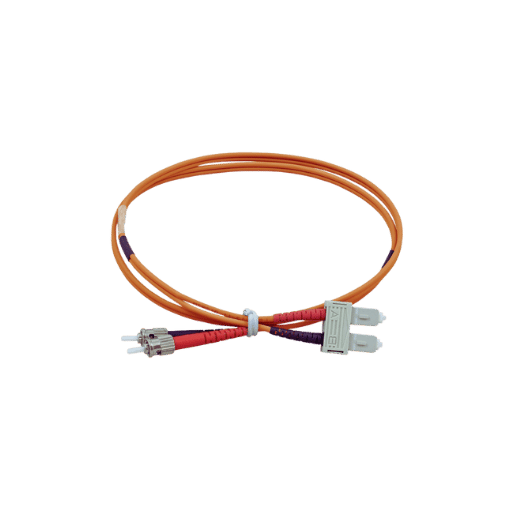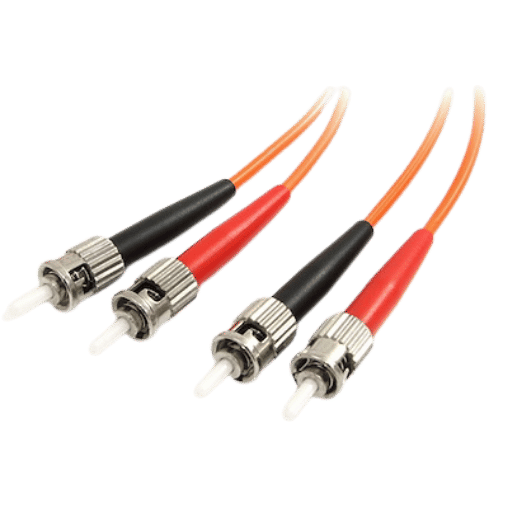In the context of optical fiber, the fitting of connectors, regarding which the ST fiber optic connector views great relevance, is discussed. This blog focuses on the details of these connectors and their use across duplex, single-mode, and multilayer cables. With the increasing demand for high-speed data transmission, knowledge of the operation and interrelation of various fiber optic parts become more relevant. In this article, the authors will examine the features and applications of the ST connectors in different optical fiber systems to broaden readers’ comprehension of how these devices enhance the performance and reliability of contemporary telecommunication systems.

An ST connector is called an STF connector or a straight-tip fiber connector. The ST fiber connector is a fiber optic connector that attaches fiber optic cables to equipment such as routers and switches. It’s cylindrical in design and has a twist-on locking system, distinguished by a firmness of a bayonet-type locking system. ST connectors are often used in networks requiring sufficient stability and high performance; single-mode and multimode ST connectors provide effective data transmission across a fiber optic system. Fiber optic technology continues to expand into more commercial applications as the cost of fiber optic cabling decreases, raising demand for fiber optic connectors.
ST fiber connectors originated in the early 1980s when AT&T sought to enhance their fiber optic interconnection options by designing, among other things, simplex connectors. The aim was to develop a strong and reliable connector that would work efficiently in all types of fiber optic applications. During this period, the ST connector was introduced, and it was the first time a usable method for affixing fiber optic systems in wide-scale use was found. The most distinguishing feature was the bayonet-type design, which provided easy insertion and removal while locked in place. Over time, the ST connector has been changed to reflect the changes in fiber technology and remained in use for present-day telecommunications and data communications networks.
ST connectors find their application in fiber optics, and they are preferred in networking applications because of their ease of use and reliability. The bayonet-type locking system on the connector is effective in making sure that there is a secure and stable connection. This is beneficial when a small signal loss is critically important, stable, and requires high performance. They are compatible with single-mode and multi-mode applications, offering a range of options for network designs involving LC and SC fiber connectors. The robust construction of the ST connectors also ensures long-term use while meeting the needs of various networking environments. This makes it a reliable ST connector for telecommunication and data communication networks.

While trying to understand the differences between ST, LC, and SC connectors, it is easy to see that all types are best suited for specific uses as they all come with unique features. Thanks to their bayonet-style coupling, ST connectors are sturdy, making them well-suited for older-styled networking systems and environments where there is a need for frequent plug-in and out, as these connectors come with a secure locking design. In contrast, LC connectors are smaller with a latch design enabling hooks; they can, therefore, be more useful in high-density areas, especially modern-day data centers, because of their small size. As for SC connectors, they come with a mechanism that allows for a push and pull insertion, which allows for effortless insertion and removal low insertion loss, and high precision. This makes the connectors ideal in telecommunications. It’s easy to see the evolution of these connectors, it’s been to address size constraints, ease of use and durability among other issues.
Among the benefits of ST connectors is their solid bayonet coupling that makes it possible to lock them to each other which is important in areas where many couplings and decouplings occur. Their simplicity and robustness mean that they can be deployed in rugged places as well as old network environments. They are also quite flexible in terms of use supporting single and multi-mode fibers making it easy to incorporate them in different networks.
On the other hand, ST connectors have some drawbacks as well. Due to their size, they occupy more space, which does not make them appropriate for high-density applications, particularly because they are bigger than LC or SC connectors. The bayonet coupling may be less convenient than the push-pull mechanism in SC connectors because the number of connection cycles may be longer. Because of changes in network technologies that call for miniaturization, the use of ST connectors might become prohibitive in modern compact data centers.
Regarding transmission distance, bandwidth requirement, and cost, single-mode and multimode ST fibers must be carefully considered when selecting. Given that, a single-mode fiber is recognized as suitable for long-distance relays because it can transmit signals over several kilometers with less loss, making it favored in telecommunications and large networks. In addition, boosted bandwidth is observed, and signal interference is reduced. Establishments under data centers are best suited for single-mode fibers as they connect various sources in a Local Area Network (LAN). This is explained by the fact that single-mode fibers are less expensive when applied in short distances due to the reduced use of interconnecting elements such as cable connectors. It is a matter of consideration for the selection to ensure there is enough distance, allowances for cost, and the amount of bandwidth in the present and the future, which will suffice the networks.

The ferrule belonging to an ST fiber connector is essential for the accommodation and precise positioning of the optical fiber within the structure and assembly of the connector. The ferrule is usually made of ceramic, metal, or plastic. It guarantees that the optical fiber is securely located and that its axis is aligned with the other fiber to reduce fiber insertion loss and back reflection. Its accurate and precise manufacturing enables the stereotyping and stability of the performance of optical fiber connections. The common thickness of ferrule in an ST connector is approximately 2.5mm, which greatly assists in retaining the most physical contact required for efficient light signal transmission. Losses and damage to Ferrule require proper cleaning; otherwise, there will always be drainage of signal loss.
ST connection patch cords stem from the British standard called the ST (straight tip). Patch cords, in general, are fiber optic cables that connect devices across a network. The main aim of these cables is to have strong outer jackets that, in return, protect the internal fibers so that transmission will be consistent even when around physical stress or EMI (electromagnetic interference). The ST connector features a straight tip and a bayonet-type shaft, which provides easy connection and disconnection, hence the reason behind the common use of patch cabling in the network. Distinctively, patch cables are available in single-mode and multi-mode fibers that enable users to utilize short or longer distances for required networks. The most suitable patch cable choice is based on the network’s bandwidth, distance, and architecture.
In ST fiber optics, coaxial duplex and simplex are the configurations that respond to specific communication requirements. Simplex configuration is suitable for applications where data communication is only needed in one direction, and thus, only one optical fiber is used. On the other hand, a duplex configuration uses two fibers and permits the establishment of two-way communication at the same time. This is the case in data applications where communications between two network nodes must be timely and continuously used. The selection of either simplex or duplex modes of operation is a question of the associated network application and the data flow it requires. However, duplex seems to be the best bet for more volatile and demanding environments.

To effectively terminate and install ST fiber optic cables, the following tools are commonly used:
These tools ensure that ST fiber optic cable systems are fixed with minimal signal losses and improved network performance, especially when Ethernet is utilized in multimode optical fiber patch cords.
Because of their importance, ST fiber optic connectors must regularly be maintained. For instance, visual inspection of the connectors for dust and other foreign particles should be done, and alcohol wipes should be recommended for cleaning. Also, using a fiber optic inspection microscope will assist in determining damages such as scratches or cracks on the tips of the connectors and whether they’re dirty or clean. Likewise, make sure that connectors are carefully installed so that they do not bend or stretch the fiber more than is tolerable since any of these activities would risk degrading the signal strength. Finally, female connectors should be protected with dust caps before storage to reduce the possibilities of mechanical stress and contamination. Proper care and maintenance would assure minimum processing loss and increase the viability of your fiber optic network.

ST Fiber optic patch cables are mainly employed in the data center and require high-quality, reliable, and fast data transmission. Owing to their sturdy construction and effective locking mechanisms, these cables are perfect for places where frequent reconnections and stable connectivity are a must. They allow quick intercommunication between servers, storage units, and networking devices, enabling high-density data distribution with less downtime. Because they’re reliable and easy to use, these ST fiber patch cables are preferred for the interconnection of the systems in data centers for smooth operations and high network efficiency.
ST connectors are of specific importance in Ethernet connectivity, especially in network configurations that require strength and accuracy. They are known to have a bayonet-style coupling, which provides them with a secure and consistent connection. This feature greatly eases their application in a network of fiber optics, which continuously transfers the amount of information as well as frequent connections or disconnections. In applications based on Ethernet, ST connectors are compatible with single-mode and multimode fiber, allowing a wide range of networking solutions. They are designed in a way to reduce signal loss, which creates a strong and effective path for data transmission crucial in upholding the performance of the network.
ST-to-ST fiber interconnection is widely used in telecommunications and industrial networking applications, where high density and reliability of the interconnection are required. These connectors are appropriate for occasions when a link has to be made and broken several times within a fairly short time, such as connecting network backbone systems, establishing secure enclaves within frames in which optical fibers are housed, and connecting equipment on a campus or building networks. The design of the ST connectors is such that the amount of signal attenuation is kept to a minimum and the operating efficiency is maximized, hence making them most suitable for high-speed broadband and long-haul communication systems where reliable fiber optic links are needed.
A: ST (Straight Tip) fiber connectors are fiber connectors that use a bayonet-style coupling mechanism for fastening. In structural aspects, both are likewise classified as FC (Ferrule Connector) connectors since both utilize a ceramic ferrule; however, ST connectors incorporate a more primitive fixing method of push and twist. ST connectors are predominant in multimode applications. FC connectors, on the other hand, are more common in singlemode applications.
A: Single mode fiber optic cables have a core diameter which is on the smaller side of things and aim to transmit a single mode of light, this leads to the ability of long-distance transmission as a result of minimal signal loss. Multimode fiber optic cables, on the other hand, have a larger core diameter, allowing them to transmit multiple light modes at once, which renders them suitable only for shorter distances with higher bandwidth. An OM1 multimode fiber type is an example of such a thing.
A: A duplex fiber optic patch cable is comprised of two fibers together, allowing for two-way data transmission. These cables are often used to make connections in a duplex manner between network devices such as switches and routers. In addition to ST and SC connectors, LC connectors are also available with duplex fiber optic patch cables, including use in single-mode and multimode configurations.
A: LC connectors (Lucent Connector) are low-profile connectors smaller in size than ST connectors and use a push-pull coupling mechanism instead of the twisting action of ST connectors. With the universal popularity of LC connectors, their usage is becoming more frequent because they are smaller and easier to handle. Because LC connectors support high density, they are common in many applications and come in simplex and duplex varieties.
A: A fiber optic adapter or coupler interconnects two fiber optic cables. It makes it possible to connect two male connectors of the same type, for example, ST to ST or LC to LC. Patch cables and patch panels would be repeatedly in use if it were not for the adapters that connect to the fiber optic networks. For starters, they allow a longer reach of cable runs by connecting them to additional network cabinets
A: The fiber connector types used in networking include ST, SC, LC, and FC. A range of fiber optic connectors have been manufactured, each with its specific purpose. For instance, ST and SC connectors are widely used in enterprise networks, whereas LC connectors are used for cable termination in high-density applications. Fibre connectors like LC and SC can also be found in telecommunications and test equipment using FC connectors. The choice of connector depends on the network’s needs, the cable type, and the equipment it will be connected to.
A: First of all, it is best practice to follow a set of procedures when terminating an ST connector; these include: 1) Stripping the fiber optic cable, 2) Cleaning the fiber, 3) Cleaving the fiber to end face the optical fiber to be normal, 4) Forcing the fiber into the connector’s ferrule coated with epoxy, 5) Drying out the epoxy, 6) Blending out the connector end face, and 7) Assessing the connector. ST connectors have a significant signal loss and require technical skills and tools to perform well.
A: Multiple fiber connectors can be mounted on the patch panels to establish easy procedures for interconnecting fibers. Thus, a patch panel directly located at your desk can hold all the fibers’ spouts with ST connectors so that when you want to use an ST-terminated cable, you just plug it into the closed ST adapter. With this arrangement, relocating, diagnosing, and managing cables in your data centers and phone rooms becomes a walk in the park.
A: ST connectors are applicable for outdoor and indoor projects as they are multifunctional cable connectors. However, when used on the outside, it is essential to use connectors and cables approved for environmental surveillance. The packaging of the ST connectors used extensively outdoors has extra moisture absorption and covers their temperature variations and UV radiation. It is to be observed that the long-term use of ST connectors outdoors must be favorable to the following: good installation processes were done, and weatherproofing measures were done.